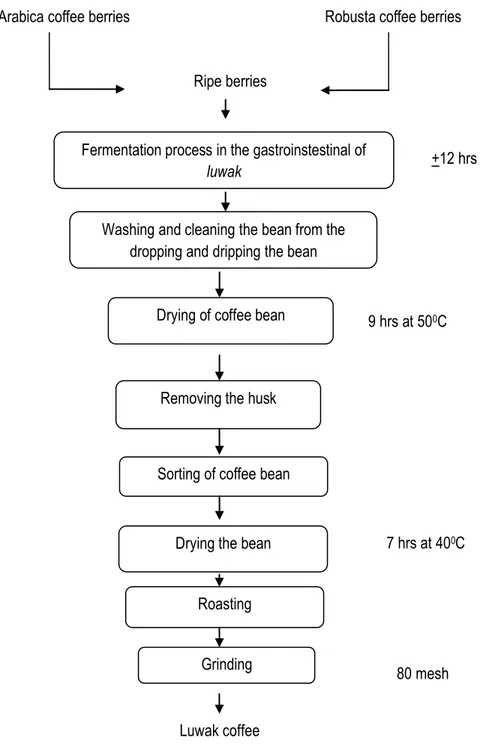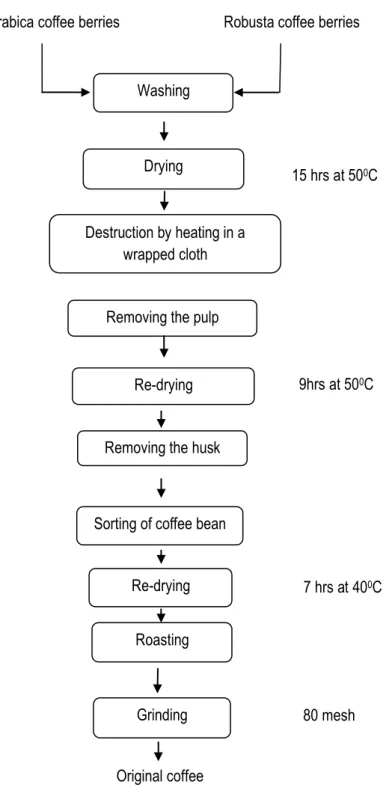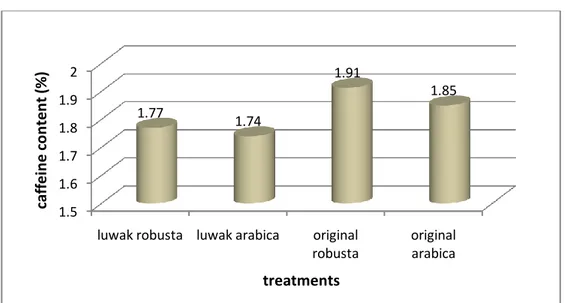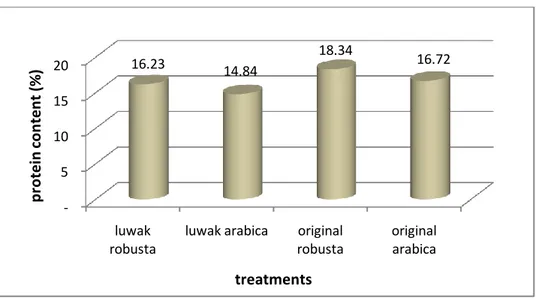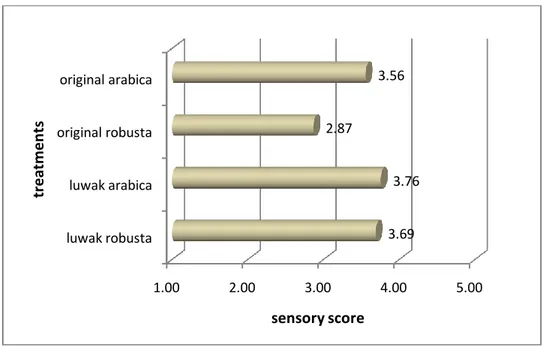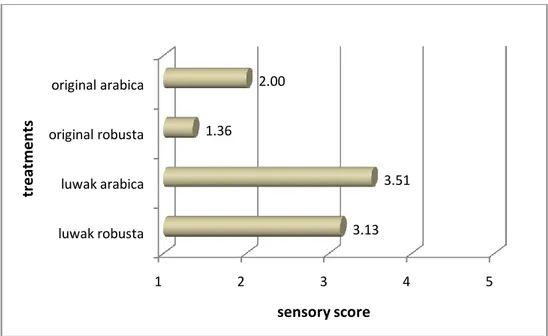(COMPARISON OF CHEMICAL CHARACTERISTICS AND SENSORY VALUE
BETWEEN LUWAK COFFEE AND ORIGINAL COFFEE FROM ARABICA (Cafeea arabica. L) AND ROBUSTA (Cafeea canephora. L) VARIETIES)
PERBANDINGAN KARAKTERISTIK KIMIA DAN NILAI SENSORI ANTARA KOPI LUWAK DAN KOPI BIASA DARI VARIETAS ARABICA (Cafeea arabica. L)
DAN ROBUSTA (Cafeea canephora. L)
Meta Mahendradatta, Zainal, Israyanti, Abu BakarTawali
Food Science and Technology Study Program, Department of Agricultural Technology, Faculty of Agriculture, Hasanuddin University, Jl. Perintiskemerdekaan Km.10, Tamalanrea, Makassar 90245
ABSTRACT
„Luwak“ coffee is well known as an extraordinary coffee due to its taste and high sell price. Special taste and odor of „luwak“ coffee are caused by the change of protein, fat and caffeine content. This research aimed to know the comparison of caffein content, proximate analysis (protein and fat), taste and odor between „luwak“ coffee and original coffee from arabika (Caffea arabica L) and robusta (Caffea canephora L) varieties. The treatments were robusta „luwak“, arabica „luwak“, robusta original and arabica original. The research parameters were sensory evaluation of taste with preference hedonic method and odor with ranking method, caffein analysis, and proximate test of protein and fat. Data was processed by using T-Test method with three replications. Sensory evaluation was conducted in a coffee shop with coffee-lovers as panelist in order to minimize the bias. The research result showed that caffein content of luwak coffee was lower than original coffee, that was 1.77%, 1.74%, 1.91%, and 1.85%, for robusta „luwak“ coffee, arabica „luwak“ coffee, robusta original coffee and arabica original coffee, respectively. Protein content of „luwak“ coffee was lower than original coffee, that was 16.23%, 14.84%, 18.34%, 16.72% for robusta „luwak“coffee, arabica „luwak“ coffee, robusta original coffee, and arabica original coffee, respectively. Fat content of „luwak“ coffee was higher than the original coffee, that was 18.45%, 19.76%, 16.41%, and 17.37%, for robusta „luwak“ coffee, arabica „luwak“ coffee, robusta original coffee, and arabica original coffee, respectively. The sensory evaluation result showed that the panelist preferred the taste of „luwak“ coffee rather than the original coffee, with score 3.69 for robusta „luwak“ coffee and 3.76 for arabica „luwak“ coffee (A2), in comparison to 2.87 for robusta original coffee and 3.55 for arabica original coffee.The similar thing also happened to the odor. The panelist preferred the odor of „luwak“ coffee rather than the original coffee, with score 3.13 for robusta „luwak“ coffee and 3.51 for arabica “luwak” coffee, in comparison to 1.36 for robusta original coffee and 2.00 for arabica original coffee. Comparison between arabica and robusta showed that fat content and sensory value of arabica coffee higher than robusta, except caffeine and protein content.
ABSTRAK
Kopi luwak sangat dikenal dan merupakan kopi yang istimewa karena rasa dan harga jual yang tinggi. Rasa dan aroma yang khas pada kopi luwak disebabkan oleh kandungan protein, lemak dan kafein. Penelitian ini bertujuan untuk mengetahui perbandingan kandungan kafein, analisis proksimat (lemak dan protein), rasa dan aroma antara kopi luwak dan kopi biasa dari jenis arabika(Caffea arabica L) dan robusta (Caffea canephora L). Perlakuannya adalah kopi „luwak“ robusta, kopi „luwak“ arabika, kopi robusta biasa dan kopi arabika biasa. Parameter pengamatan adalah analisis sensori terhadap rasa dengan uji kesukaan metode hedonik dan terhadap aroma dengan uji ranking, analisis kafein, analisis proksimat terhadap protein dan lemak. Pengolahan data menggunakan T-test dengan tiga kali ulangan. Pengujian sensori dilakukan di sebuah warung kopi dengan panelis penikmat kopi untuk meminimalkan bias. Hasil penelitian menunjukkan bahwa kandungan kafein pada kopi luwak lebih rendah dibandingkan kopi biasa, yaitu 1.77%, 1.74%, 1.91%, dan 1.85%, untuk kopi luwak robusta, kopi luwak arabika, kopi biasa robusta dan kopi biasa arabika, berturut-turut. Kandungan protein kopi luwak lebih rendah daripada kopi biasa yaitu 16.23%, 14.84%, 18.34%, 16.72% untuk kopi luwak robusta, kopi luwak arabika, kopi biasa robusta dan kopi biasa arabika, berturut-turut. Kandungan lemak pada kopi luwak lebih tinggi daripada kopi biasa yaitu18.45%, 19.76%, 16.41%, and 17.37%, untuk kopi luwak robusta, kopi luwak arabika, kopi biasa robusta dan kopi biasa arabika, berturut-turut. Hasil pengujian sensori menunjukkan bahwa panelis lebih menyukai rasa dari kopi luwak daripada kopi biasa dengan nilai 3.69 untuk kopi luwak robusta dan nilai 3.76 untuk kopi luwak arabika, dibandingkan dengan nilai 2.87 untuk kopi biasa robusta dan nilai 3.55 untuk kopi biasa arabika. Hal yang sama juga terjadi pada pengujian sensori terhadap aroma. Panelis lebih menyukai aroma kopi luwak dibandingkan kopi biasa dengan nilai 3.13 untuk kopi luwak robusta dan nilai 3.51 untuk kopi luwak arabika, dibandingkan dengan nilai 1.36 untuk kopi robusta biasa dan nilai 2.00 untuk kopi biasa arabika. Perbandingan antara jenis arabika dan robusta menunjukkan bahwa kandungan lemak dan nilai sensori kopi arabika lebih tinggi daripada kopi robusta, kecuali kandungan kafein dan protein.
INTRODUCTION
Coffee is believed to be the most popular beverage in the world. Among all of the known species, the most important are Coffea arabica L (arabica coffee), C. canephora Pierre (robusta coffee), which account respectively, for about 75 and 24% of the total world coffe production (Casal, 2003). This plant is categorized as export commodity which has high economic value in the world, beside as outstanding commodity developed in Indonesia. Coffee is one of some kind of drinks which is preferred of many people. One effort to increase the economic value of coffee is make it into luwak coffee.
One hundred years ago, the Indonesians have discovered the coffee bean that has been subjected to fermentation in the gastrointestinal tract of Asia Palm Civet exhibits a very thick and aromatic taste and the Indonesians collected the droppings of Asia Palm civet to obtain the coffee beans for making coffee (Pei-Jung et al, 2009). That coffee is famous as luwak coffee which known as a generic term of coffee drink from coffee bean produced by luwak (Paradoxurus hermaphrodirus). The famous of this coffee has been recognized since the past as coffee plantation was opened in Indonesia during Netherland colonial time, until 1950. At that time many luwak lived who took good fruits as their foods, included coffee fruit/ coffee berries. There were only the best and mature coffee berries which
have been eaten by luwak. Coffee beans based on this treatment are believed as special and different coffee compared to the original and common processing.
This research aimed (1) to determine the content of caffeine in luwak coffee and original coffee from arabica and robusta species, (2) to determine the proximate analysis (protein and lipid) in luwak coffee and original coffee from arabica and robusta species, and (3) to know the comparison acceptability towards luwak coffee and original coffee from arabica and robusta species.
METHODOLOGY Material and method
Materials used in this research were coffee from arabica and robusta variety with supporting material aluminum foil and plastic. Chemicals used for analysis were chloroform, MgO, KOH, H2SO4, H3SO3 2%, NaOH 30%, HCL 0.01 N. aluminium foil, labelled paper and plastic. Equipment used for processing and analysis was pan for roasting, grinder, vacuum dryer, oven with blower, analytical balance, Soxhlet, Micro-Kjeldahl.
Original coffee was processed and analysis in Laboratory of Processing and Laboratory of Analytical Chemistry and Food Quality Control at Food Science and Technology Study Program, Department of Agricultural Technology, Faculty of Agriculture, Hasanuddin University, Makassar. Luwak coffee was processed at Perumahan Taman Sudiang Permai, Makassar.
Research treatments
There were 4 samples used in this research, namely: arabica luwak coffee, robusta luwak coffee, arabica original coffee and robusta original coffee
Processing of coffee
Figure 1: Processing steps of luwak coffee from arabica and robusta species
Arabica coffee berries Robusta coffee berries
Ripe berries dibatang
Fermentation process in the gastroinstestinal of
luwak
Sorting of coffee bean
Washing and cleaning the bean from the dropping and dripping the bean
Drying of coffee bean
Removing the husk
Drying the bean Roasting Grinding Luwak coffee +12 hrs 9 hrs at 500C 7 hrs at 400C 80 mesh
Figure 2: Common processing steps of coffee from arabica and robusta species Arabica coffee berries Robusta coffee berries
Re-drying Drying Washing
Destruction by heating in a wrapped cloth
Removing the pulp
Removing the husk
Sorting of coffee bean
rice Roasting Grinding Original coffee Re-drying 15 hrs at 500C 9hrs at 500C 7 hrs at 400C 80 mesh
Research parameters
Analysis of caffeine (method Bailey-Andrew)
Five gram of fine sample was weighed, transferred into Erlenmeyer and added with five gram MgO and 200 ml aquadest. Condensor was set, boiled slowly for 2 hours, cooled and diluted until volume 500 ml, then filtered. A 300 ml filtrate was transferred into boiling flask, added 10 ml sulfuric acid (1:9), boiled until the rest volume was 100 ml. Solution decanted into separator funnel, boiling flask was rinsed with sulfuric acid (1:9), shaked several times with chloroform in amount of 25 ml, 20 ml, 15 ml, 10 ml and 10 ml, respectively. All collected solution was transferred into separator funnel, added by 5 ml KOH 1%, shaked and kept until the solution was clearly separated. After that the bottom solution (caffeine in chloroform) was taken out and decanted into Erlenmeyer. Ten ml chloroform was added, shaked and kept until clearly separated then the same procedure was applied. This step was carried out once again. Caffeine solution in chloroform was heated in waterbath until the residue was left then it was dried in oven at 100 0C until constant weight has been achieved. It was crude caffeine. The pure caffeine can be determined by analysis N by using micro Kjeldahl.
Caffein in sample (g) = gram N x 3.464 x 500/300 Sensory evaluation (Larmond, 1977)
Methode used was preference test by hedonic methode for determine the acceptance of panellist for taste and ranking method for odor. For hedonic method, the panelists should give evalution based on their preference on taste. Sensory score used was 5 (like very much), 4 (like), 3 (normal), 2 (do not like), 1 (do not like very much). For ranking method, the panelists should rank the samples based on their preference on odor of coffee served, from 1 (like very much) until 4 (do not like). There were 15 panelists used in this research as coffee lovers.
Protein analysis (AOAC, 1998)
A 0.5 gram sample was weighed and put into Kjeldahl flask 100 ml. One gram selenium and 10 ml H2SO4 was added. Kjeldahl flask was shaked until all sample was wetted with H2SO4 then the sample was destructed until clear. After cooled the clear solution was transferred into volume tasks 100 ml and rinsed with aquadest and then aquadest was added until mark. An Erlenmeyer 100 ml consisted of 2% of 10 ml H3SO3 added by 4 drops of indicator solution was prepared. Five ml 30% NaOH 30% and aquadest was distilled until volume in flask about 50 ml. The end of distilled flask was rinsed with aquadest and the solution was tittered with HCl solution or H2SO4 0.0222 N.
% Protein =VxNx0.014x6.25xFp Gram Sample x 100 % Note : V = titer volume N = Normality of HCl or H2SO4 solution Fp = dilution factor
Lipid analysis (AOAC, 1998)
One gram sample in form of powder was weighed and wrapped with filter paper, then put into Soxhlet extractor. Diethyl ether was decanted into lipid flask. The extraction process was conducted for minimal 5 hours until all sovent that come down to the flask was clear. The solvent was distilled and it collected, then the fat was extracted in oven at 1050C. After drying until constant weight and cooled in dessicator, the weight of fat was weighed again. Lipid content was calculated according to equation:
% 100 ) ( % x gram sample of weight lipid of weigh lipid Data Processing
Data was processed by using T-test with triplicate.
RESULT AND DISCUSSION Chemical analysis
Caffeine content
Figure 3: Caffeine content of luwak coffee and original coffee
Caffeine (1, 3, 7 –trimethylxanthine) is an alkaloid and is generally reponsibe for 0.9 – 2.5% of coffee dry matter composition (Ky et al., 2001). Low to moderate caffeine intake is generally associated with improvement in alertness, learning capacity, exercise performance, and perhaps moods (Nehlig, 1999). Based on T-test analysis, the treatment arabica luwak coffee and robusta original coffee showed significantly different toward caffeine content. The other treatments did not show any significantly different towards caffeine content. The result of caffeine content in this research showed that the highest caffeine content was the original robusta 1.91% while the lowest caffeine content was arabica luwak coffee 1.74%. Figure 3 showed that caffeine content of original robusta was higher than original arabica. Caffeine content of coffee bean ranges between 0.8 – 2.5% and by robusta can be higher until 4% (Belitz et al., 2001). The result also showed that the decrease of caffeine content was happened to robusta luwak coffee and arabica luwak coffee as well. The low content of caffeine was due to the fermentation process in gastrointestinal tract of luwak that can reduce the caffeine content and result the special odor of luwak coffee. Roasting process reduces the caffeine content only in a very small amount (Belitz et al., 2001). 1.5 1.6 1.7 1.8 1.9 2
luwak robusta luwak arabica original robusta original arabica 1.77 1.74 1.91 1.85 caf fe in e co n te n t (% ) treatments
Protein Content
Figure 4: Protein content of luwak coffee and original coffee
Based on T-test analysis, the treatment of robusta luwak coffee and robusta original coffee showed significantly different on protein content (p>0.01). The same result was also found for the comparison between arabica luwak and robusta original, and between arabica luwak and arabica original. Other comparison of treatment did not show significant difference on protein content. The highest protein content was showed by robusta original 18.34%, while the lowest protein was arabica luwak 14.84%. Figure 4 showed that protein content of robusta original coffee was higher than arabica original coffee. Robusta coffee has bitter taste and it related to protein content.
The result showed that protein content decreased at robusta luwak and arabica luwak. According to Marcone (2004), the luwak coffee bean were found to be lower in total proteins which means that proteins were partially broken down and leached out during the digestion process inside the animals’s gastrointestinal tract. Some researches found that fermentation in the gastrointestinal tract of luwak increased its quality because the optimal temperature was 240 - 2600 C. Beside that, it was helped by the bacteria in the gastrointestinal tract. Secretion of proteolytic enzyme degraded protein of coffee bean. It resulted low peptide and free amino acid. The change of protein and free amino acid produced a unique taste. A study has also reported that the total concentration of free amino acids does not change significantly with the chemical reaction occurring during teh harvest season and the postharvest processing steps, such as drying, fermentation and storage (Arnold et al., 1996). Protein content of luwak coffee was lower than original coffee due to optimal decomposition of protein through fermentation process. -5 10 15 20 luwak robusta
luwak arabica original robusta original arabica 16.23 14.84 18.34 16.72 p ro te in co n te n t (% ) treatments
Lipid content
Figure 5: Lipid content ofluwak coffee and original coffee
The lipid fraction of coffee composed mainly of triacylglycerols, sterols and tocopherols, the typical components found in all common edible vegetable oils. The two most important coffee species, arabica and robusta contain between 7 and 17% lipid. The lipid content of green arabica coffee beans averages some 15%, whilst robusta coffees much less, around 10% (Speer and Kölling-Speer, 2006). Based on T-test analysis, the comparison between each treatment showed that arabica luwak and robusta original have significantly different on lipid content (p>0.01). The same result applied also for the comparison between arabica luwak and arabica original, and between arabica luwak and arabica original. Other comparison of treatment did not show significant difference on lipid (p<0.05).
The result of lipid content showed that the highest lipid was arabica luwak coffee19.76% and the lowest was robusta original coffee16.41%. In comparison between two species of coffee, arabica coffee showed higher lipid content than robusta. There is an increase of lipid content of coffee after processed in luwak’s gastrointestinal tract in comparison to original coffee. High content of lipid made the taste more delicious.
Sensory evaluation
Taste
Sensory test was conducted to evaluate the preference of panelists on the taste of each coffee sample. Panelists used in this research were people as coffee lover and the test has been conducted in a cafe where coffee is served as special and main drink.
-5 10 15 20 luwak robusta luwak arabica original robusta original arabica 18.45 19.76 16.41 17.37 li p id co n te n t (% ) treatments
Figure 6: Sensory evaluation of taste of luwak coffee and original coffee
The result of statistical analysis showed that there was significantly difference on the taste of coffee from each treatment. (p>0.01). Robusta original coffee was less preferred by the panelists. Based on sensory test the best preference of coffee taste was arabica luwak. Coffee from arabica species has more specific and milder taste than that from robusta species. It gives sour taste that is not possessed by robusta coffee. Due to its low protein and high lipid content, luwak coffee gives special taste. Since proteins are responsible for much of the flavour, particularly of bitteness, it is clear that the lower protein content of luwak coffee is one reason for a less bitter coffee (Marcone, 2004). Robusta coffee showed higher protein content that arabica coffee and it related to the respond of panelists on the taste of coffee. Arabica luwak coffee was preferred more than robusta luwak coffee based on this research. This also applied to original coffee; arabica original coffee was preferred more than robusta original coffee. High content of lipid in coffee lead to unique and delicious taste. Arabica coffee showed higher content of lipid than robusta coffee and it related to the respond of panelists on the taste of that coffee.
The taste of coffee is influenced also by roasting process and grinding the coffee bean. The finest the coffee powder, the easiest it solve to hot water, so it increase the taste of coffee. This related to Mulato (2002) that particles of coffee powder have larger surface than whole bean. As a consequent, compounds fresheners solved easily into warm water.
Result of sensory evaluation showed that the most preferred treatment was arabica luwak coffee. This is in accordance with the result of chemical analysis that arabica luwak coffee showed the lowest caffeine and protein content and the highest lipid content. As a consequent, the taste of arabica luwak coffee was most preferred by the panelists.
1.00 2.00 3.00 4.00 5.00 luwak robusta luwak arabica original robusta original arabica 3.69 3.76 2.87 3.56 sensory score tr e atm e n ts
Odor
Figure 7: Sensory evaluation of odor of luwak coffee and original coffee
Ranking method for preference test was used to evaluate the respond of panelist on the odor of coffee. The panelists should rank the sample based on the preference on its odor. Statistical analysis has resulted the data that each treatment of coffee bean showed significantly different (p>0.01) on the odor of coffee. Figure 7 showed that the most prefererred odor by the panelists was arabica luwak coffee, followed by robusta luwak coffee, arabica original coffee and robusta original coffee. Coffee bean that was fermented naturally in the gastrointestinal tract of luwak changed the chemical composition of coffee bean and gave specific taste and odor of coffee due to the enzymatic process and bacteria found in gastrointestinal tract of luwak.
The odor of coffee was produced from roasting process of coffee bean and also fermentation process. According to Marcone (2004), after roasting it was noted that there were significant differences in the flavor profile of luwak coffee versus the controls when analyzed by an electronic nose for volatile aroma compounds. Gonzales-Rios et al (2006) in their research reported that there were 27 compounds which have been detected by olfactometry and these were mostly esters, alcohols and aldehydes.the olfactory notes were quite varied, mixing pleasant (fruity, floral, sweet, caramel and jam) and unpleasant odors (acrid, cabbage, pungent, sour and burnt)
CONCLUSION
From this research, it has been concluded that,
1. Caffeine content of luwak coffee was lower than original coffee; robusta coffee was higher than Arabica coffee.
2. Protein content of luwak coffee was lower than original coffee; robusta coffee was higher than arabica coffee. Lipid content of luwak coffee was higher than original coffee; Arabica coffee was higher than robusta.
1 2 3 4 5 luwak robusta luwak arabica original robusta original arabica 3.13 3.51 1.36 2.00 sensory score tr e atm e n ts
3. The taste and odor of luwak coffee was more preferred than the taste of original coffee; Arabica was more preferred than robusta. The odor of original robusta coffee was valued very low.
REFERENCES
AOAC. 1998. Official Methods of Analysis of the AOAC. Washington DC.
Arnold, U., Ludwig, E. 1996. Analysis of free amino acids in green coffee beans. II. Changes of the amino acid content in Arabica coffees in connection with postharvest model treatment. Z. Lebensm. Unters.Forsch. 203: 379 – 384
Belitz, H.-D. W. Grosch und P. Schieberle, 2001. Lehrbuch der Lebensmittelchemie, Springer-Verlag, Berlin, Heidelberg, New York.
Casal, S., M. RuiAlves, Eulalia Mendez, M. Beatriz P., P. Oliviera, and Margarida A. Ferreira, 2003. Discrimination between arabica androbusta coffee species on the basis of their amino acid enantiomers, J. Agric Food Chem 51 (22): 6495 - 6501
Gonzales-Rios, O., M.L. Suarez-Quiroz, R. Boulanger, M. barel, B. Guyot, J-P.Guiraud, and S. Schorr-Galindo. 2006. Impact of “ecological” post-harvest processing on the volatile farction of coffee beans: I. Green Coffee. J. Food Comp and Analysis 20 (3-4): 289 – 296.
Ky, C., Louarn, J., Dussert, S., Guyot, B., Hamon, S., Noirot, M., 2001. Caffeine, trigonelline, chlorogenic acids and sucrose diversity in wild Coffeaarabica L. and C. canephora P. accessions. Food Chem. 75: 223 – 230
Larmond, E. 1977.“Laboratory Methods for Sensory Evaluation of Food”. Research Institute, Canada Department of Agriculture, Ottawa.
Marcone, N.F. 2004. Composition and properties of Indonesia palm civet coffee (Kopi Luwak) and Ethipian civet coffe. Food Res. Int 37 (9): 901 - 912
Mulato, Sri. 2002. Simposium Kopi 2002 dengan tema Mewujudkan Perkopian Nasional yang Tangguh melalui Diversifikasi Usaha Berwawasan Lingkungan dalam Pengembangan Industri Kopi Bubuk Skala Kecil untuk Meningkatkan Nilai Tambah Usaha Tani Kopi Rakyat. Denpasar : 16 – 17 Oktober 2002. Pusat Penelitian Kopi dan Kakao Indonesia.
Nehlig, A., 1999. Exploring biotechnology. in Adriana Farah, Tomas de Paulis, Daniel P. Moreira, Luiz C. Trugo, and Peter R. Martin, 2006. Chlorogenic acids and lactones in regular and water-decaffeinated Arabica coffees, J. Agric. Food Chem 54: 374 – 381
Pei-Jung, Li, Li Chao-Chia, Li Chao-Hsiang. 2009. Method for manufacturing coffee by solid state fermentation. US Patent Pub. No.: US2010/0239711 A1. Pub. Date: Sep.23.2010.
Speer, K. and I. Kölling-Speer, 2006. The lipid fraction of the coffee bean. Braz. J. Plant. Physiol. 18 (1): 201 – 216.
